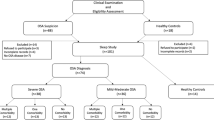Abstract
Purpose
The relationship of plasma malondialdehyde (MDA) with major parameters of PSG was investigated to find out if there was a correlation between these variables.
Methods
Polysomnograms were done on a total of 37 adults who do not have a history of any systemic illness, smoking, and supplement use. Plasma MDA measurements and their relationship with PSG parameters were analyzed.
Results
The mean MDA concentrations in patients with lower AHI values were also lower than those in the patients with higher AHI (p < 0.001). Higher predominance of apnea in patients with similar AHI values, longer mean apnea durations, O2 saturation dips to < 90%, and higher ODI values predicted higher plasma MDA concentrations.
Conclusions
Higher oxidative stress measurements predicted more severe clinical picture. These findings show that oxidative stress measurement with MDA may provide a simple tool to screen patients for OSA and help select them for PSG study appropriately, if indicated

Similar content being viewed by others
References
Senaratna C, Perret J, Lodge C, Lowe A, Campbell B, Matheson M, Hamilton G, Dharmage S (2017) Prevalence of obstructive sleep apnea in the general population: a systematic review. Sleep Med Rev 34:70–81
Ramachandran S, Josephs L (2009) A meta-analysis of clinical screening tests for obstructive sleep apnea. Anesthesiology 110(4):928–939
Lavie L (2008) Intermittent hypoxia: the culprit of oxidative stress, vascular inflammation and dyslipidemia in obstructive sleep apnea. Expert Rev Respir Med 2(1):75–84
Lavie L (2015) Oxidative stress in obstructive sleep apnea and intermittent hypoxia—revisited—the bad ugly and good: implications to the heart and brain. Sleep Med Rev 20:27–45
Schwedhelm E (2004) Urinary 8-iso-Prostaglandin F2 as a Risk Marker in Patients With Coronary Heart Disease: A Matched Case-Control Study. Circulation 109(7):843–848
Seet R, Lee C, Lim E, Tan J, Quek A, Chong W, Looi W, Huang S, Wang H, Chan Y (2010) Oxidative damage in Parkinson disease: measurement using accurate biomarkers. Free Radical Biol Med 48(4):560–566
Nadeem R, Molnar J, Madbouly E, Nida M, Aggarwal S, Sajid H, Naseem J, Loomba R (2013) Serum inflammatory markers in obstructive sleep apnea: a meta-analysis. J Clin Sleep Med 9(10):1003–1012
De Luca Canto LG, Pachêco-Pereira C, Aydinoz S, Major P, Flores-Mir C, Gozal D (2015) Diagnostic capability of biological markers in assessment of obstructive sleep apnea: a systematic review and meta-analysis. J Clin Sleep Med 11(1):27–36
Yamauchi M, Nakano H, Maekawa J, Okamoto Y, Ohnishi Y, Suzuki T, Kimura H (2005) Oxidative stress in obstructive sleep apnea. Chest 127(5):1674–1679
Svatikova A, Wolk R, Lerman L, Juncos L, Greene E, McConnell J, Somers V (2005) Oxidative stress in obstructive sleep apnoea. Eur Heart J 26(22):2435–2439
Jordan W, Cohrs S, Degner D et al (2005) Evaluation of oxidative stress measurements in obstructive sleep apnea syndrome. J Neural Transm 113(2):239–254
Barceló A, Miralles C, Barbé F, Vila M, Pons S, Agustí A (2000) Abnormal lipid peroxidation in patients with sleep apnoea. Eur Respir J 16(4):644
Vatansever E, Surmen-Gur E, Ursavas A, Karadag M (2010) Obstructive sleep apnea causes oxidative damage to plasma lipids and proteins and decreases adiponectin levels. Sleep Breath 15(3):275–282
Celec P, Hodosy J, Behuliak M, Pálffy R, Gardlík R, Halčák L, Mucska I (2011) Oxidative and carbonyl stress in patients with obstructive sleep apnea treated with continuous positive airway pressure. Sleep Breath 16(2):393–398
Tichanon P, Wilaiwan K, Sopida S, Orapin P, Watchara B, Banjamas I (2016) Effect of continuous positive airway pressure on airway inflammation and oxidative stress in patients with obstructive sleep apnea. Can Respir J 2016:7. https://doi.org/10.1155/2016/3107324(Article ID 3107324)
Itzhaki S, Dorchin H, Clark G, Lavie L, Lavie P, Pillar G (2007) The effects of 1-year treatment with a herbst mandibular advancement splint on obstructive sleep apnea, oxidative stress, and endothelial function. Chest 131(3):740–749
Bakan E, Fidan V, Alp H, Baygutalp N, Cokluk E (2015) Effect of modified fujita technique uvulopalatoplasty on oxidative DNA damage levels in patients with obstructive sleep apnea syndrome. J Craniofac Surg 26(5):e392–e396
Vuralkan E, Mutlu M, Fırat I, Akaydin S, Sagit M, Akin I, Miser E, Ardic S (2013) Changes in serum levels of MDA and MMP-9 after UPF in patients with OSAS. Eur Arch Otorhinolaryngol 271(5):1329–1334
Dal-Fabbro C, Garbuio S, D’Almeida V, Cintra F, Tufik S, Bittencourt L (2014) Mandibular advancement device and CPAP upon cardiovascular parameters in OSA. Sleep Breath 18(4):749–759
Cho J, Suh J, Kim Y, Hong S, Kim I, Kim J (2015) Reduction in oxidative stress biomarkers after adenotonsillectomy. Int J Pediatr Otorhinolaryngol 79(9):1408–1411
Acknowledgements
Informed consent was obtained from all individual participants included in the study. All of the authors declare no conflicts of interest.
Author information
Authors and Affiliations
Corresponding author
Ethics declarations
Conflict of interest
The authors disclose no conflicts of interest.
Informed consent
All patients were given verbal and written information regarding the nature of the study and informed consent was taken.
Additional information
Publisher's Note
Springer Nature remains neutral with regard to jurisdictional claims in published maps and institutional affiliations.
This article is part of the Topical Collection on sleep apnea syndrome Guest Editors: Manuele Casale, Rinaldi Vittorio.
Rights and permissions
About this article
Cite this article
Savaş, Ö., Süslü, A.E., Lay, I. et al. Assessment of the relationship between polysomnography parameters and plasma malondialdehyde levels in patients with obstructive sleep apnea. Eur Arch Otorhinolaryngol 276, 3533–3538 (2019). https://doi.org/10.1007/s00405-019-05536-z
Received:
Accepted:
Published:
Issue Date:
DOI: https://doi.org/10.1007/s00405-019-05536-z




